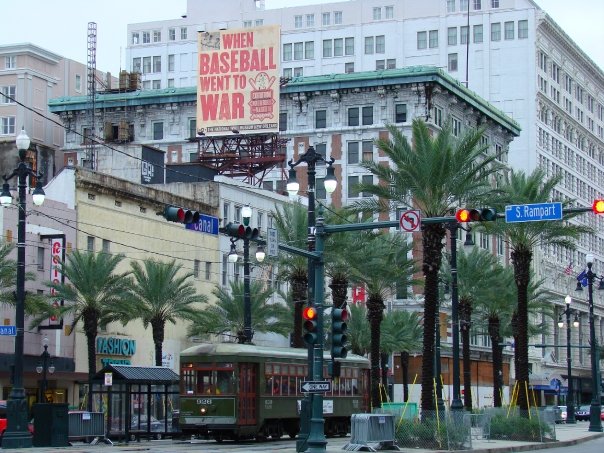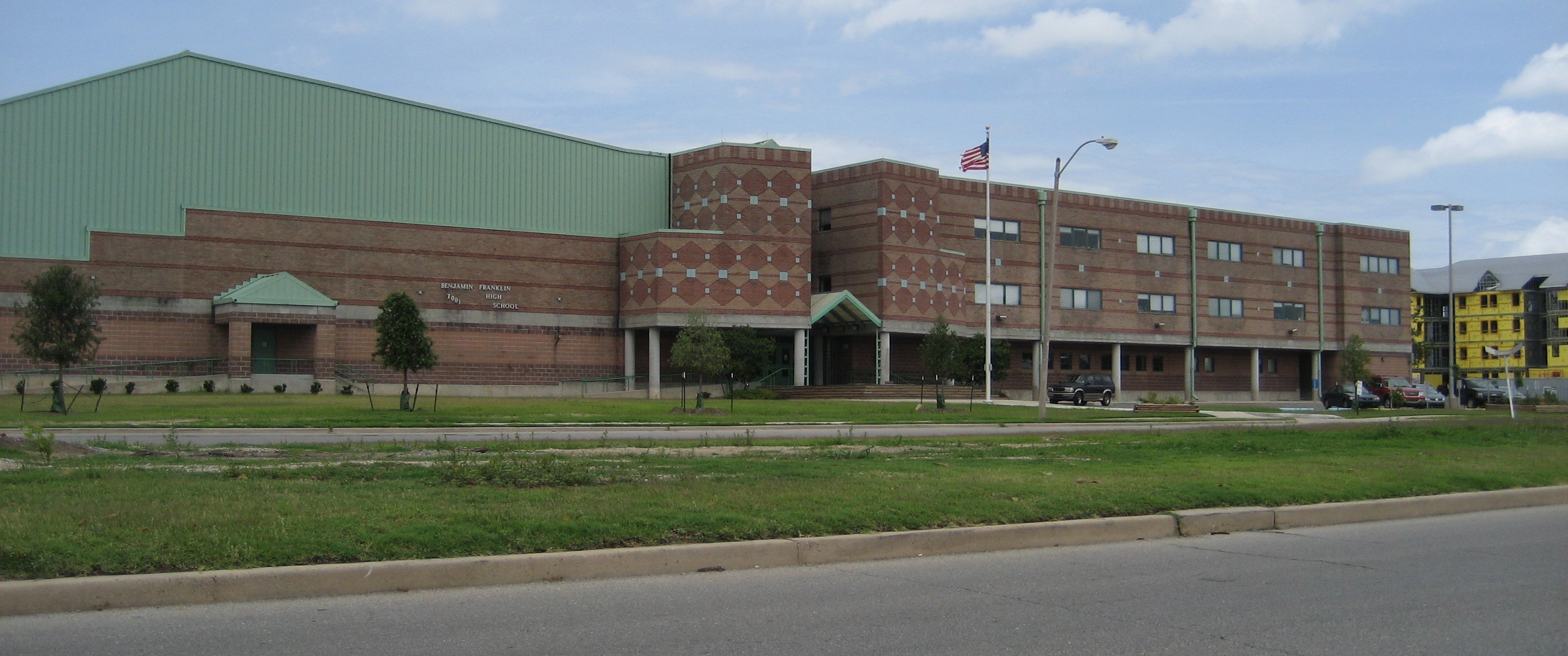|
Industrial Canal
The Industrial Canal is a 5.5 mile (9 km) waterway in New Orleans, Louisiana, United States. The waterway's proper name, as used by the U.S. Army Corps of Engineers and on NOAA nautical charts, is Inner Harbor Navigation Canal ( IHNC). The more common "Industrial Canal" name is used locally, both by commercial mariners and by landside residents. The canal connects the Mississippi River to Lake Pontchartrain. It separates New Orleans East from the rest of the city, and the Lower 9th Ward from the Upper 9th Ward. Approximately half of the waterway's course, from Industrial Lock to a point north of the Florida Avenue Bridge, is confluent with both the Gulf Intracoastal Waterway and the Mississippi River Gulf Outlet ( MRGO). The entirety of the canal passes through the 9th Ward of the city. Along the riverfront, the canal constitutes the boundary of the Upper 9th Ward on the upriver side of the canal and the Lower 9th Ward neighborhood on the downriver side. Near the l ... [...More Info...] [...Related Items...] OR: [Wikipedia] [Google] [Baidu] |
Mississippi River
The Mississippi River is the second-longest river and chief river of the second-largest drainage system in North America, second only to the Hudson Bay drainage system. From its traditional source of Lake Itasca in northern Minnesota, it flows generally south for to the Mississippi River Delta in the Gulf of Mexico. With its many tributaries, the Mississippi's watershed drains all or parts of 32 U.S. states and two Canadian provinces between the Rocky and Appalachian mountains. The main stem is entirely within the United States; the total drainage basin is , of which only about one percent is in Canada. The Mississippi ranks as the thirteenth-largest river by discharge in the world. The river either borders or passes through the states of Minnesota, Wisconsin, Iowa, Illinois, Missouri, Kentucky, Tennessee, Arkansas, Mississippi, and Louisiana. Native Americans have lived along the Mississippi River and its tributaries for thousands of years. Most were hunter-gathere ... [...More Info...] [...Related Items...] OR: [Wikipedia] [Google] [Baidu] |
Florida Avenue Bridge
The Florida Avenue Bridge is a vertical lift bridge spanning the Industrial Canal in New Orleans, Louisiana. The bridge has one railroad track, two vehicle lanes and two sidewalks. A parallel high-elevation four-lane roadway bridge is planned. History The Florida Avenue Bridge takes its name from Florida Avenue, formerly the Florida Walk alongside the Florida Canal. Florida Avenue was one of the first four bridges built by the Port of New Orleans in the 1920s in order to provide railroad access across the Inner Harbor-Navigational Canal, locally referred to as the Industrial Canal. The three of the original four identical bridges are in use today—St. Claude Avenue, Almonaster Avenue, and Seabrook. While St. Claude Bridge no longer carries rail service, Almonaster and Seabrook remain dedicated to rail service only. The original Florida Avenue Bridge was removed in 2000 as a hazard to marine navigation and replaced with the current modern, steel structure which was completed i ... [...More Info...] [...Related Items...] OR: [Wikipedia] [Google] [Baidu] |
Canal Street, New Orleans
Canal Street (french: rue du canal) is a major thoroughfare in the city of New Orleans. Forming the upriver boundary of the city's oldest neighborhood, the French Quarter or ''Vieux Carré'', it served historically as the dividing line between the colonial-era (18th-century) city and the newer American Sector, today's Central Business District. Up until the early 1800s, it was the Creoles who lived in the Vieux Carré. After the Louisiana Purchase (1803), a large influx of other cultures began to find their way into the city via the Mississippi River. A number of Americans from Kentucky and the Midwest moved into the city and settled uptown. Along the division between these two cultures, a canal was planned. The canal was never built but the street which took its place received the name. Furthermore, the median of the street became known as the neutral ground, acknowledging the cultural divide. To this day, all medians of New Orleans streets are called neutral grounds. On ... [...More Info...] [...Related Items...] OR: [Wikipedia] [Google] [Baidu] |
Canal Lock
A lock is a device used for raising and lowering boats, ships and other watercraft between stretches of water of different levels on river and canal waterways. The distinguishing feature of a lock is a fixed chamber in which the water level can be varied; whereas in a caisson lock, a boat lift, or on a canal inclined plane, it is the chamber itself (usually then called a caisson) that rises and falls. Locks are used to make a river more easily navigable, or to allow a canal to cross land that is not level. Later canals used more and larger locks to allow a more direct route to be taken. Pound lock A ''pound lock'' is most commonly used on canals and rivers today. A pound lock has a chamber with gates at both ends that control the level of water in the pound. In contrast, an earlier design with a single gate was known as a flash lock. Pound locks were first used in China during the Song Dynasty (960–1279 AD), having been pioneered by the Song politician and n ... [...More Info...] [...Related Items...] OR: [Wikipedia] [Google] [Baidu] |
Bayou St
In usage in the Southern United States, a bayou () is a body of water typically found in a flat, low-lying area. It may refer to an extremely slow-moving stream, river (often with a poorly defined shoreline), marshy lake, wetland, or creek. They typically contain brackish water highly conducive to fish life and plankton. Bayous are commonly found in the Gulf Coast region of the southern United States, especially in the Mississippi River Delta, though they also exist elsewhere. A bayou is often an anabranch or minor braid of a braided channel that is slower than the mainstem, often becoming boggy and stagnant. Though fauna varies by region, many bayous are home to crawfish, certain species of shrimp, other shellfish, catfish, frogs, toads, salamanders, newts, American alligators, American crocodiles, herons, lizards, turtles, tortoises, spoonbills, snakes, and leeches, as well as many other species. Etymology The word entered American English via Louisiana French in Louisiana an ... [...More Info...] [...Related Items...] OR: [Wikipedia] [Google] [Baidu] |
French Quarter
The French Quarter, also known as the , is the oldest neighborhood in the city of New Orleans. After New Orleans (french: La Nouvelle-Orléans) was founded in 1718 by Jean-Baptiste Le Moyne de Bienville, the city developed around the ("Old Square" in English), a central square. The district is more commonly called the French Quarter today, or simply "The Quarter," related to changes in the city with American immigration after the 1803 Louisiana Purchase. Most of the extant historic buildings were constructed either in the late 18th century, during the city's period of Spanish rule, or were built during the first half of the 19th century, after U.S. purchase and statehood. The district as a whole has been designated as a National Historic Landmark, with numerous contributing buildings that are separately deemed significant. It is a prime tourist destination in the city, as well as attracting local residents. Because of its distance from areas where the levee was breached during ... [...More Info...] [...Related Items...] OR: [Wikipedia] [Google] [Baidu] |
Carondelet Canal
The Carondelet Canal, also known as the Old Basin Canal, was a canal in New Orleans, Louisiana, U.S.A., operating from 1794 into the 1920s – nearly 135 years. Construction of the canal began in June 1794, on the orders of the Spanish Governor of Louisiana, Francisco Luis Héctor de Carondelet, for whom the canal was named. Construction was accomplished by the forced labor of convicts and by slaves whose work was donated by townspeople. The 1.6 mile-long canal started at Bayou St. John, which connected with Lake Pontchartrain, and went inland to what was then the back edge of New Orleans, behind the French Quarter in the Tremé neighborhood. The first shallow, narrow version of the canal was completed by the end of 1794. Over the next two years, further work made the canal wider and deeper. The canal officially opened in 1796, serving dual purposes of drainage and shipping, but when Carondelet was transferred away from Louisiana the next year, the canal fell into neglect. ... [...More Info...] [...Related Items...] OR: [Wikipedia] [Google] [Baidu] |
Spain
, image_flag = Bandera de España.svg , image_coat = Escudo de España (mazonado).svg , national_motto = ''Plus ultra'' (Latin)(English: "Further Beyond") , national_anthem = (English: "Royal March") , image_map = , map_caption = , image_map2 = , capital = Madrid , coordinates = , largest_city = Madrid , languages_type = Official language , languages = Spanish , ethnic_groups = , ethnic_groups_year = , ethnic_groups_ref = , religion = , religion_ref = , religion_year = 2020 , demonym = , government_type = Unitary parliamentary constitutional monarchy , leader_title1 = Monarch , leader_name1 = Felipe VI , leader_title2 = Prime Minister , leader_name2 = Pedro Sánchez , legislature = C ... [...More Info...] [...Related Items...] OR: [Wikipedia] [Google] [Baidu] |
Industrial Canal Post-katrina
Industrial may refer to: Industry * Industrial archaeology, the study of the history of the industry * Industrial engineering, engineering dealing with the optimization of complex industrial processes or systems * Industrial city, a city dominated by one or more industries * Industrial loan company, a financial institution in the United States that lends money, and may be owned by non-financial institutions * Industrial organization, a field that builds on the theory of the firm by examining the structure and boundaries between firms and markets * Industrial Revolution, the development of industry in the 18th and 19th centuries * Industrial society, a society that has undergone industrialization * Industrial technology, a broad field that includes designing, building, optimizing, managing and operating industrial equipment, and predesignated as acceptable for industrial uses, like factories * Industrial video, a video that targets “industry” as its primary audience * Industri ... [...More Info...] [...Related Items...] OR: [Wikipedia] [Google] [Baidu] |
Gentilly, New Orleans
Gentilly is a broad, predominantly middle-class and racially diverse section of New Orleans, Louisiana. The Gentilly neighborhood is bounded by Lake Pontchartrain to the north, France Road to the east, Bayou St. John to the west, and CSX Transportation railroad tracks to the south. The major north-south streets are Franklin Avenue, Elysian Fields Avenue, St. Anthony, St. Bernard, St. Roch, Paris, Wisner, A.P. Tureaud (formerly London) Avenue and Press. The east-west streets are Lakeshore Drive, Leon C. Simon, Allen Toussaint Blvd (a section of which was formerly called Hibernia), Prentiss, Harrison, Filmore, Mirabeau, Hayne, Chef Menteur, and Gentilly. History The first part of Gentilly to be developed was along the Gentilly Ridge, a long stretch of high ground along the former banks of Bayou Gentilly. A road, originally "Gentilly Road", was built on the ridge, and formed the eastern path into the oldest part of the city, today's French Quarter to Chef Menteur Pass. The high g ... [...More Info...] [...Related Items...] OR: [Wikipedia] [Google] [Baidu] |





